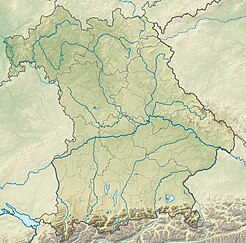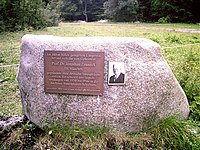Radio station at the Herzogstand
|
Radio station at the Herzogstand
|
||
|---|---|---|
| Basic data | ||
| Place: | At the Herzogstand near Schlehdorf | |
| Country: | Bavaria | |
| Country: | Germany | |
| Altitude : | 781 m above sea level NHN | |
| Coordinates: 47 ° 37 ′ 43.5 ″ N , 11 ° 19 ′ 21 ″ E | ||
| Use: | Telecommunication system | |
| Demolition : | 1946 | |
| Data on the transmission system | ||
| Construction time: | 1920-1927 | |
| Operating time: | 1927-1946 | |
| Waveband : | VLF transmitter | |
| Send type: | Directional radio | |
| Position map | ||
|
|
||
The radio station at the Herzogstand was a radio system that was built and operated from 1920 to 1946 at the Herzogstand near Kochel am See in Bavaria. The system was designed by C. Lorenz AG as an independent resource for radio traffic on long-wave waves between Germany and the Far East, as the existing large radio stations mainly served traffic to the west.
From 1930 the facility was used as a research and test station for the Technical University of Munich for ionospheric research.
The construction of the mountain antenna
Since the costs for the masts of a large station were prohibitive for the company, the antenna system should be hung in the mountains. The 1735 m high Herzogstand between Kochelsee and Walchensee in the Bavarian Alps seemed particularly suitable for several reasons: The summit is accessible all year round, there was enough drinking water and cooling water available at the station, and the nearby Walchensee power plant promised a safe, inexpensive energy supply.
There was no experience with the intended design of the antenna. The free span was a distance of over 2.5 km, with a height difference of 800 m. In order to achieve a sufficient height of the antenna above ground, the rope should run horizontally at the lower suspension point, which required enormous tension on the rope. Due to the additional expected load from wind, but also from snow and ice, only steel wire of the highest strength was considered.
A first thin steel cable was stretched in the summer of 1920. Radiation measurements at wavelengths of 12.6 km and 9.7 km resulted in 1.3 times the radiation and 1.6 times that of the overseas transmitter Eilvese compared to the Nauen radio station . Until the early summer of 1925, three antennas were drawn in a fan shape to the summit ridge of the Herzogstand. In order to achieve better conductivity, the steel cable was provided with an aluminum sheath. The ropes were made in a specially constructed rope-making facility in the summit area. In the area of the summit, the antennas were fixed to steel anchors embedded in concrete. A movable suspension was used at the lower anchoring point to allow the ropes to yield when exposed to snow and ice.
The station building
The station building for the transmitters and a residential building were built by the Munich Post Office under the direction of Robert Vorhoelzer and Walther Schmidt in 1927 in Vallunga above Lake Kochel. Extensive earthing systems were also built here.
After completion, further expansion and operation of the station did not appear to be technically and economically sensible, since global radio links on shortwave could now be carried out more cost-effectively with much smaller antennas.
Ionospheric research
After radio amateurs had proven in the mid-1920s that short waves are much better suited for global radio traffic than long waves, the systems were no longer needed for radio traffic. From 1930 onwards, they were made available to the Physics Institute of the Technical University of Munich for research work. The first German ionospheric research station was set up here under the direction of Jonathan Zenneck . Outside of his program times, Zenneck's assistant Georg Goubau used the Munich radio station to broadcast short signals (impulses) on medium wave . The echo signals were first registered a few km away in Kochel, then at the station itself. Later, especially by Walter Dieminger, impulse broadcasts were carried out with their own transmitters, which were also received at greater distances. Separate antennas were built for this; the mountain antenna was dismantled in 1934. Kochel-Berlin was the first long-distance impulse connection with which Rudolf Eyfrig obtained information about the different propagation paths of short waves between the ionosphere and the earth. A transceiver system with variable frequency was built by Georg Goubau and Theo Netzer, commissioned from 1937 and operated continuously until 1946. The results provided a picture of the density of free electrons as a function of altitude, which was helpful in predicting the propagation conditions.
The end of the station
After the end of the Second World War, the station operation continued under US supervision until 1946, but all existing registrations were brought to America. Because ionospheric research was forbidden in the occupation era, operations were then prohibited, all facilities dismantled and the operational buildings demolished.
Today, next to a memorial stone near the Walchensee power plant, only the remains of the anchorages of the antenna cables and some of the foundations of the station buildings in the forest can be found. The remains of the antenna anchors have been included in the Bavarian list of monuments by the Bavarian State Office for the Preservation of Monuments .
Similar plants
A long wave radio station with a mountain antenna was put into operation in 1923 near Malabar on the island of Java in what is now Indonesia for radio communications with Holland.
Similar transmitting antennas were built after the Second World War for three transmitters of the Omega navigation method (in Aldra, Hawaii and Trinidad), for the long-wave transmitter JXN near Aldra, for the Jim Creek Naval Radio Station and for the long- wave transmitter ICV on Tavolara .
A similar antenna exists at the Portofino transmitter .
literature
- EAPariser: The main station Herzogstand . Radio-Umschau, issue 12, May 4, 1924
- H. Rohde: How we got the antenna on the Herzogstand . Radio-Umschau, issue 13, May 11, 1924
- O. Scheller: The construction of the mountain antenna at the Herzogstand . Electrical communications technology, Volume 3, Issue 7, July 1926
- G. Goubau u. J. Zenneck: Arrangement for echo measurements on the ionosphere . High frequency technology and electroacoustics, Volume 40, Issue 3, Sept. 1932
- W. Dieminger: Ionosphere FIAT Review of German Science, Volume 17, Sept. 1948
- R. Eyfrig: Kleinheubacher Reports published by the Central Telecommunications Office in Darmstadt, Volume 18, 1975
- The radio station at the Herzogstand . Documentation, edited by H. Renner and M.Rothe, Kochel, 2014
Web links
Individual evidence
- ↑ Florian Aicher, Uwe Drepper (ed.): Robert Vorhoelzer - An architect's life. The classic modernism of the Post, Munich 1990, p. 283.






